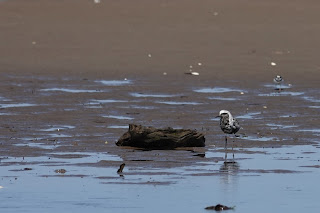NATURE MONCTON INFORMATION LINE, August 20, 2021 (Friday)
To respond by e-mail, please address your message to the information line editor, nelsonpoirier435@gmail.com .
Please advise the editor at nelsonpoirier435@gmail.com if any
errors are noted in wording or photo labelling.
For more information on Nature Moncton, check the website at www.naturemoncton.com .
Edited by: Nelson Poirier nelsonpoirier435@gmail.com
Transcript by: Louise Nichols nicholsl@eastlink.ca
Info Line # 506-384-6397 (384-NEWS)
** Louise Nichols did her shorebird
survey at Ann’s Acres near Cape Tormentine Thursday afternoon. Louise is not finding as many birds at that
site as when she first started surveying it, but she did see 8 different
species on Wednesday, including one WHIMBREL which is the first time she
has seen that species there at that site.
Louise got some excellent photos that very clearly show field marks of
these shorebirds.
** Jean-Paul and Stella LeBlanc have
had a sudden clustering of grasshoppers increasing in number in their
Bouctouche yard. They seem to be
increasing daily and they noted more than 100 on the back of their home. BugGuide has suggested the species to be the RED-LEGGED
GRASSHOPPER, one of our more common grasshopper species. The LeBlancs wonder if any others have noted
this sudden grasshopper scenario.
** Aldo Dorio got photos of BOBOLINKS
from different angles at Hay Island on Thursday that nicely show field
marks. As mentioned in a recent edition,
gender and age can be more difficult to call at this time of year with plumage
molts in progress with this species.
** It’s Friday and time to see what
next week’s sky has in store for us to see, courtesy of sky-guru Curt Nason.
This Week’s Sky at a Glance, 2021
August 21 – August 28
One of the prettiest constellations can be seen halfway up in the southeastern
sky around 10 pm. Delphinus the Dolphin is composed of a small diamond-shaped
asterism with a star tailing off to the right, and it doesn’t take a lot of
imagination to picture a dolphin leaping out of the sea. Although its stars are
not bright, its compact shape is eye-catching. Below it is the watery
constellations of Capricornus, Aquarius, Piscis Austrinus and Pisces. In
mythology, Poseidon had designs on the sea nymph Amphitrite but she hid on him.
A dolphin kept track of her and eventually convinced her that the sea god was
an okay guy, and it was rewarded with a place of honour in the sky. The diamond
part of the constellation has also been called Job’s Coffin but the origin of
this is unknown.
Above Delphinus, and within the Summer Triangle, are two other small
constellations called Sagitta the Arrow and Vulpecula the Fox. Like Delphinus,
Sagitta does resemble its namesake but apparently the fox is too sly to give
itself away readily. Sagitta is supposedly the arrow shot by Hercules to kill
an eagle (Aquila), which had been commanded by Zeus to peck out the liver of
Prometheus each day to punish him for giving humans the secret of fire.
Binoculars might reveal the tiny gaseous remnants of an expired star, called
the Dumbbell Nebula or M27, above the arrowhead, and the Coathanger cluster is
to the upper right of the fletching.
This Week in the Solar System
Saturday’s sunrise in Moncton is at 6:26 am and sunset will occur at 8:17 pm,
giving 13 hours, 51 minutes of daylight (6:32 am and 8:20 pm in Saint John).
Next Saturday the Sun will rise at 6:35 am and set at 8:04 pm, giving 13 hours,
29 minutes of daylight (6:41 am and 8:08 pm in Saint John).
The Moon is below Jupiter this Saturday evening and it is full on Sunday
morning, the Mi’gmaw Ripening Moon. You will need binoculars and a clear sky to
see Mercury low in the west midweek, setting about 40 minutes after sunset, and
Mars is a tougher target setting seven minutes sooner. Venus is an early
evening beacon in the west while Jupiter and Saturn climb higher in the
southeast. Jupiter’s Red Spot can be seen with a telescope around 9:30 pm
Tuesday and 11 pm Thursday.
Questions? Contact Curt Nason at nasonc@nbnet.nb.ca.
Nelson Poirier,
Nature Moncton












